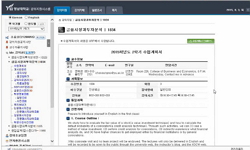A cross-sectional distribution of the investment rates of manufacturing establishments in Korea, based on the Mining and Manufacturing Surveys of 2011 through 2014, reveals a fat right tail and an asymmetry between positive and negative investment rat...
http://chineseinput.net/에서 pinyin(병음)방식으로 중국어를 변환할 수 있습니다.
변환된 중국어를 복사하여 사용하시면 됩니다.
- 中文 을 입력하시려면 zhongwen을 입력하시고 space를누르시면됩니다.
- 北京 을 입력하시려면 beijing을 입력하시고 space를 누르시면 됩니다.



Policy Implications of Investment Rate Distributions in the Korean Manufacturing Sector = Policy Implications of Investment Rate Distributions in the Korean Manufacturing Sector
한글로보기https://www.riss.kr/link?id=A106981758
- 저자
- 발행기관
- 학술지명
- 권호사항
-
발행연도
2020
-
작성언어
-
- 주제어
-
등재정보
SSCI,SCOPUS,KCI등재
-
자료형태
학술저널
- 발행기관 URL
-
수록면
445-480(36쪽)
- DOI식별코드
- 제공처
-
0
상세조회 -
0
다운로드
부가정보
다국어 초록 (Multilingual Abstract)
A cross-sectional distribution of the investment rates of manufacturing establishments in Korea, based on the Mining and Manufacturing Surveys of 2011 through 2014, reveals a fat right tail and an asymmetry between positive and negative investment rates, reflecting the fixed cost of capital adjustment and the partial irreversibility of investment. This finding reveals that the aggregate responsiveness to the investment support policy will be greater during a boom than during a recession. A heterogeneous plant model designed to explain the cross-sectional distribution of investment rates observed in the data demonstrates that the response of aggregated investment to investment subsidy is 21.8% higher during a boom than during a recession. Our study also suggests that concentrating subsidies in establishments with small employment size will increase the investment inducement effect of the policy rather than provide equal subsidies for establishments of all sizes.
동일학술지(권/호) 다른 논문
-
- 한국경제학회
- ( Hyunbae Chun )
- 2020
- SSCI,SCOPUS,KCI등재
-
- 한국경제학회
- ( Seunghoon Han )
- 2020
- SSCI,SCOPUS,KCI등재
-
The Monetary Policy Reaction Function in Korea with Multi-level Factors
- 한국경제학회
- ( Byoungsoo Cho )
- 2020
- SSCI,SCOPUS,KCI등재
-
- 한국경제학회
- ( Dmitry Shapiro )
- 2020
- SSCI,SCOPUS,KCI등재





 KCI
KCI KISS
KISS






